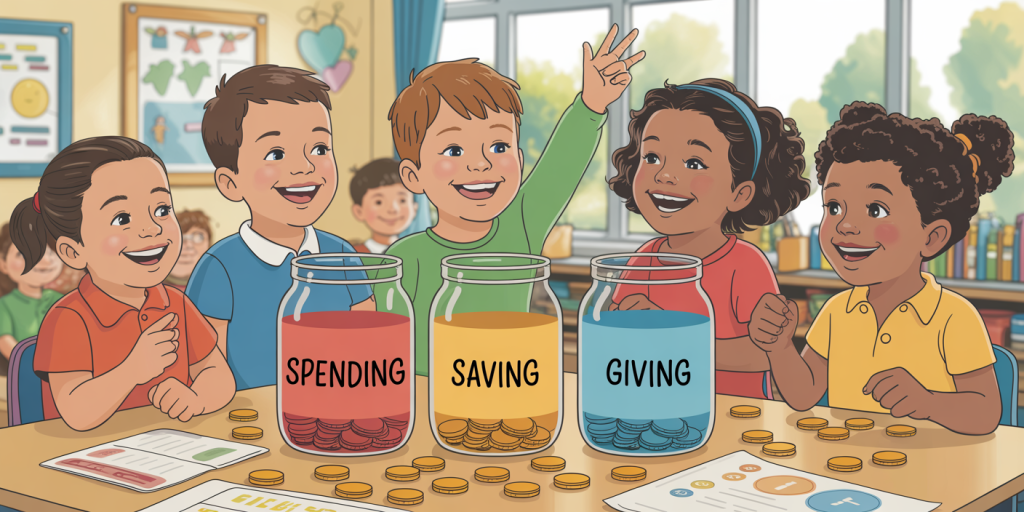Understanding money management from an early age is a vital life skill that can significantly influence a child’s future financial well-being. In an increasingly complex economic world, money literacy is no longer optional but essential for children to grow into responsible adults capable of making informed financial decisions. Teaching kids about finance isn’t just about saving pennies; it is about embedding values of responsibility, critical thinking, and planning in everyday situations.
According to a 2020 T. Rowe Price Parents, Kids & Money Survey, 67% of parents felt teaching money management skills was extremely important for their children, yet only 49% felt very confident about their ability to teach these skills effectively. This gap underscores the need for deliberate approaches to financial education tailored to children’s age and comprehension levels. By equipping young learners with the tools to understand concepts like budgeting, saving, and delayed gratification, parents and educators can foster a foundation that strengthens lifelong financial health.

The Importance of Early Financial Education
Financial habits develop early, often influenced by family behaviors and societal norms. Research from the University of Cambridge suggests that children as young as seven can grasp basic money concepts, such as earning and spending responsibly. Early financial education fosters numerical literacy and instills confidence, helping children avoid common pitfalls like impulsive spending or debt accumulation later in life.
Moreover, kids raised with strong financial skills are more likely to succeed academically and socially, as money management closely aligns with goal-setting, discipline, and problem-solving. For instance, a case study from Junior Achievement America showed that students who participated in financial literacy programs were more likely to save regularly and demonstrate improved economic decision-making skills. This underscores that financial literacy does not solely impact an individual’s pocket but also enhances cognitive development and resilience.
Practical Strategies for Teaching Kids About Money
Teaching kids about finance must be interactive and engaging to resonate. One effective method is incorporating real-life experiences into lessons. For example, parents can involve children in grocery shopping, allowing them to compare prices and make budget-conscious choices. Providing a fixed allowance linked with household chores can teach the value of earning money and managing expenses.

Furthermore, implementing tools like savings jars or digital banking apps designed for children can simplify abstract financial concepts. Apps such as Greenlight or GoHenry enable kids to visualize their savings, set goals, and learn digital payment handling under parental supervision. Studies by the National Endowment for Financial Education found that children using these apps increased their saving frequency by 30% compared to those who did not.

Another powerful strategy is storytelling through books or games that highlight financial decision-making. Classics like “The Berenstain Bears’ Trouble with Money” or interactive board games like “Monopoly” help children understand consequences and rewards linked to financial choices.
Budgeting Basics: Teaching Planning and Prioritization
Budgeting is often viewed as an adult-only activity, but introducing it early can cultivate strong financial discipline. Teaching children to budget can start with dividing their allowance into categories such as spending, saving, and giving. For example, if a child receives $10 weekly, allocating $4 for spending, $4 for saving, and $2 for charity can teach prioritization and generosity simultaneously.
Practical exercises could involve comparing the cost of desired toys or activities, encouraging children to save incrementally for bigger purchases. This method shifts the focus from instant gratification to strategic planning. Real case examples demonstrate that kids who learn to budget show improved money control and delayed gratification skills later in life, qualities linked to higher credit scores and lower debt rates in adulthood (source: Consumer Financial Protection Bureau, 2019).
The table below displays a simple budgeting plan for children with sample percentages and their behavioral impacts:
| Category | Suggested Percentage | Purpose | Behavioral Impact |
|---|---|---|---|
| Spending | 40% | Immediate wants and needs | Develops self-control |
| Saving | 40% | Future goals or emergencies | Encourages goal setting |
| Giving/Donation | 20% | Charitable contributions | Fosters empathy and sharing |
This simple framework not only teaches math skills but also emphasizes that managing money wisely involves balancing needs, wants, and generosity.
The Role of Technology in Financial Education
In today’s digital age, technology plays a pivotal role in educating children about finance. Digital wallets, online bank accounts for kids, and educational apps make financial learning accessible and engaging. A report by Common Sense Media (2021) highlights that nearly 85% of children aged 8-12 own or have access to a digital device, providing an avenue for technology-driven financial education.
Apps that use gamification techniques such as earning points, completing missions, or achieving savings milestones can motivate children to maintain good financial habits. For instance, the app “PiggyBot” allows children to track their allowance, set savings goals, and simulate spending, reinforcing disciplined financial behaviors through rewards and positive reinforcement.
Additionally, online platforms provide parents with tools to monitor transactions and guide kids through mistakes without real-world financial consequences. This safety net facilitates experiential learning, aligning with educational psychology that emphasizes learning through practice.
Real-Life Cases Demonstrating Financial Literacy Outcomes
Examining real-world scenarios sheds light on how effective financial education shapes children’s futures. Take the example of Jack, a 14-year-old who started managing a part-time job alongside his school duties. His parents introduced a budgeting system, where he had to save 50% of his earnings and spend the rest. Within two years, Jack saved enough to buy a used laptop, funding it without relying on credit.
Another illustration comes from a school in New York that implemented regular financial literacy classes starting from grade four. Surveys indicated a 40% increase in students’ awareness of saving, budgeting, and credit. By the time those students were in high school, several opened their own savings accounts, demonstrating heightened confidence in financial matters.
The American Institute of CPAs reports that financially literate individuals are 30% more likely to avoid high-interest debt and 50% more likely to plan for long-term goals such as college or homeownership. These examples reinforce that teaching kids about money is not a theoretical exercise but has tangible impacts on life trajectories.
Future Perspectives: Preparing the Next Generation for Financial Success
Looking ahead, financial education is evolving to adapt to changing economic landscapes and technological advancements. The COVID-19 pandemic highlighted the importance of emergency savings and flexible budgeting, lessons that are increasingly incorporated into educational curricula. Policymakers are also pushing for mandated financial literacy classes in schools globally, recognizing the urgent need for equipping youth with these critical skills.
Future approaches may involve personalized financial coaching using artificial intelligence to tailor lessons based on children’s learning styles and financial habits. Moreover, as cryptocurrencies and digital assets become more mainstream, expanding financial curricula to include emerging trends will be essential. Equity in access to financial education will also remain a focal point to ensure that children from diverse socio-economic backgrounds can build strong financial foundations.
In conclusion, teaching kids about finance is an investment in their future independence and security. Through practical strategies, leveraging technology, and real-world applications, children can develop robust money management skills that last a lifetime. As society continues to recognize the critical role of financial literacy, the next generation will be better equipped to navigate the complexities of the financial world confidently and responsibly.

Deixe um comentário